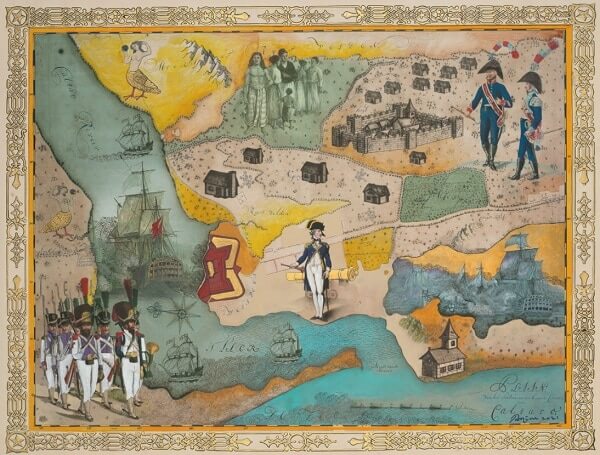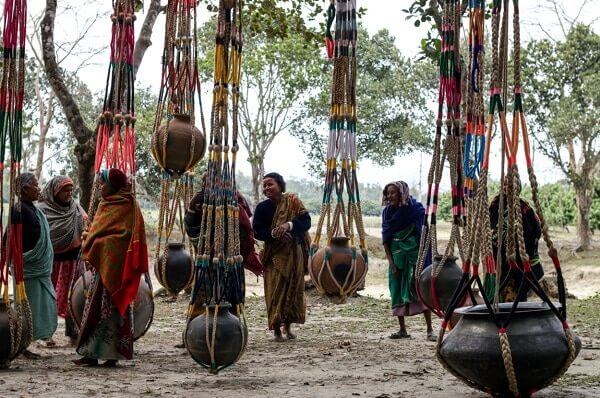In the 10th edition of QAGOMA’s Asia Pacific Triennial (APT10), the exhibition hopes to look to the future of art and the world we inhabit together.
APT10 includes 69 artworks with new and recent work by emerging and established artists and collectives, about 150 individuals from 30 countries have contributed to this collection.
This time, 11 South Asian artists have enriched the exhibition with their stories of ‘how to navigate through time and space, reimagine histories and explore connections to culture and place’.
artists – Rathin Barman, Sumakshi Singh and Mayur & Tushar Vayeda – will feature among over 150 artists at the 10th Asia Pacific Triennial of Contemporary Art. the event will be held at @QAGOMA from 4 Dec till 25 April, 2022. More info
https://t.co/DKhkUVSkSa #APT10QAGOMA pic.twitter.com/wAHVitYWNi
— Barry O’Farrell AO (@AusHCIndia) October 28, 2021
The free and expansive onsite exhibition will be on display across both galleries, QAG (Queensland Art Gallery) and GOMA (Gallery of Modern Art), featuring a wide variety of materials and techniques, with large-scale installations, immersive multimedia artworks, sculpture, textiles, paintings, photography and video.
Here are some familiar links to India and neighbouring countries; Pakistan, Nepal, Bangladesh, Myanmar, and Sri Lanka.
Mayur and Tushar Vayeda
The Vayeda brothers, Mayur (29) and Tushar (38), live and work in Ganjad, India.
Mayur and Tushar Vayeda are brothers who proudly belong to the indigenous Warli people of Ganjad, Maharashtra, India. While carrying forward the ancient practices of Warli painting from a young age through family members, the brothers quit other career prospects to explore, document, and share their culture.

Rathin Barman
Barman, 40, hailing from Tripura, India, lives and works in Kolkata.
He records stories of migration and home-building in order to study the social fabric of cities, by highlighting the quirks that are etched in urban architecture. A regular visitor of Kolkata’s migrant neighbourhoods, he researches the history and transformation of buildings and gathers stories from families and communities.

“In particular, he considers how ambiguous ownership and tenancy structures result in hybrid communities occupying buildings in different ways, leaving visible traces in the architecture.”
Barman’s sculptures combine everyday industrial materials such as concrete and steel with more precious materials — polished brass. From monumental installations to small, detailed sculptures, his work records the nuanced evolution of urban structures.
Shubigi Rao
Rao, 46, hailing from Mumbai, India, lives and works in Singapore.
Shubigi Rao’s work primarily focuses on research into libricide — ‘the destruction of books, songs, stories and dialects — as a factor in broader ethnic disparities and cultural genocides’. Collectively titled Pulp, this research has manifested in the form of films, installations, and two award-winning volumes of writing and photography.

Rao’s installation A small study of silence comprises a film, photographs, and ink drawings. In this work, Rao draws on her formative childhood experience of living within the rich acoustic space of the Nainital jungle, in the Himalayan foothills, where each sound is part of an intricate communication network.
3AM
3AM is a performance art group from Myanmar, made up of three artists Ma Ei, Ko Latt, and Yadanar Win. After participating in a group exhibition in Sweden, in 2016, the trio decided to begin collaborating together. They are also the first performance art collective in Myanmar and each member maintains their own individual performance and multimedia practices, as well as signalling the important role performance has played in the development of contemporary art in Myanmar.

Improvisation, live public performances, studio productions, and on-location photographic series, all form 3AM’s body of work highlighting the country’s ongoing political instability, as well as issues of gender, sexuality, inequality, and other social situations.
Interestingly, the artists rely only on their physical bodies and each other to convey the ‘urgency and threats in the subjects they target’.
Pala Pothupitiye
Pothupitiye, 46, from Deniyaya, Sri Lanka, lives and works in Colombo.
In Sri Lanka’s contemporary art scene, Pala Pothupitiye’s practice draws on both international history and local ritual. In particular, he questions European colonial paradigms and their legacies regarding the development and perception of the SL’s art, culture, and identity.

A majority of his work is dedicated to manipulating and re-appropriating cartographic devices, particularly old maps of the cities, ports and forts of Sri Lanka, including those made during the country’s Portuguese, Dutch and British colonial periods.
Bani Abidi
Abidi, 50, hailing from Karachi, Pakistan, lives and works in Berlin, Germany, and Karachi.
Abidi’s works revolve around the contemporary conditions of Pakistan and its immediate region, like issues of security, democracy, urban and social change, and the ‘instrumentalised’ patriotisms that form the basis of the relationship between Pakistan and India.
Recently, after Abidi’s international travels, her work has also emphasised imbalances in the telling of histories.

Her work Memorial to Lost Words 2016–18 pays homage to the memory of more than a million Indian soldiers who served in WWI — including some 70 000 who gave their lives — and whose accounts have been largely excluded from history. The work is presented through an immersive sound installation produced by Abidi and an arrangement of letters drawn from the book Indian Voices of the Great War: Soldiers’ Letters, 1914–18 (1999) by David Omissi.
READ ALSO: Kirthana Selvaraj in her ‘green suit‘ at the Archibald
Karan Shrestha
Shrestha, 36, hailing from Nepal, works in Kathmandu and in Mumbai, India.

Karan Shrestha is an artist who concerns himself with the social and political structures of Nepal, he does this through an experimental mode of practice that combines video, drawing, photography, and text.
With firsthand footage stitched together with documentary and found footage, his final video works contain layers of history, violence, natural disaster, military mobilisation, mass gatherings, and ‘acts of waiting’.
Shrestha also creates intricate ink drawings that incorporate a similar approach, displaying symbols and characters from reality, mythology, and imagination. The artist’s works construct a dense vocabulary of ‘Nepali narratives, peoples, and histories’.
Sumakshi Singh
Singh, 41, born in Delhi, lives and works in Gurgaon, India.
In her artistic career, Sumakshi Singh has developed a candid and reactive approach to material and space.
In her practice, she rigorously explores aspects of spatial intervention that ‘play in the gap between conditioned knowledge and direct perception, and in the spaces between physical objects and illusory experiences.’

The architectural features of Singh’s grandparents’ house in Delhi feature majorly in her recent sculptural studies in thread and shadow. In Afterlife, ‘groundless thread drawings’of windows, doors, staircases and other architectural elements capture the house frozen in time, ‘like a flower pressed between the pages of a book.’
Subash Thebe Limbu, Yakthung people
The 40-year-old artist, born in Dharan, Nepal, lives and works in London, UK, and Kathmandu. In his art practice, Subash Thebe Limbu explores the relationship between art and social change, which results in sound, animation, music, performance, and painting.

Adeela Suleman
Suleman, 46, lives and works in Karachi, Pakistan.
She is known for her sculptural works, which often bring to the fore themes of political urgency. For the last eight years, Suleman has produced painted works on obscure found ojbects. These works aim to explore history to consider violent conflicts and how they have been depicted. Her paintings feature techniques and motifs of South Asian miniature painting and draw on different historical events, sites and artistic traditions.

In a related series titled ‘Home Front’, painted metal cleavers display delicate paintings of the Himalayan mountain range, drawn from postcards that circulate in Pakistan.
“Through these idealised landscapes painted on flesh-cutting objects, Suleman recognises the ongoing conflict in the region.”
Kamruzzaman Shadhin & Gidree Bawlee Foundation Of Arts
The works of Kamruzzaman Shadhin (48) and the Gidree Bawlee Foundation Of Arts (established in 2001) are also showcasing their work at APT10. For over two decades, artist Kamruzzaman Shadhin has developed new possibilities for contemporary art in Bangladesh. In 2001, he founded the Gidree Bawlee Foundation of Arts in order to work with local communities and to ameliorate social inclusivity through collaboration.

His work The fibrous souls, constructed with 70 giant shikas (embroidered, reticulated bags typically made of jute strings that are tied to an exposed beam), explores part of Bengal’s colonial history, inspired by the families that followed the railway tracks after the British East India Company established the Eastern Bengal Railway and later displaced in Bangladesh.
“Working with 13 women from jute-making families to construct the shikas, along with a handful of local craftspeople to create the pots and connecting jute ropes, Kamruzzaman and Gidree Bawlee have constructed a giant hanging system of shikas, laid out as a map of the historic railway.”
(The installation of this artwork has been delayed due to changing freight and logistics conditions during COVID-19. It will be installed in February 2022.)
The 10th Asia Pacific Triennial of Contemporary Aart (APT10) will be on until 25th April 2022.




